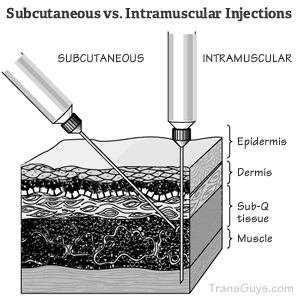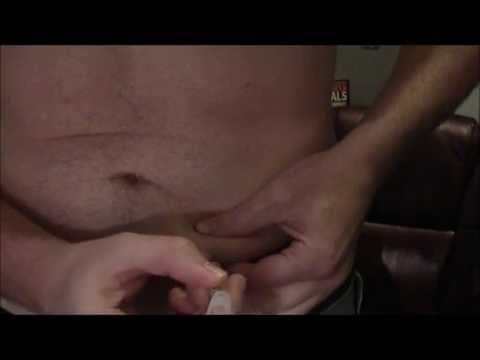In North America, the leaflet that comes with injectable testosterone says that T should only be injected intramuscularly, but a growing number of endocrinologists are recommending subcutaneous injections as a convenient, effective alternative.
 What Are Subcutaneous Injections?
What Are Subcutaneous Injections?
aka. SC, SQ, sub-cu, sub-Q or subcut.
The difference between sub-q and IM injections is basically the depth of the injection. A subcutaneous injection is administered into the layer of skin directly below the dermis and epidermis, with a depth of 4-8mm (0.15″-0.2″), while an IM injection is administered into muscle, with a depth of at least 2.5cm (1″.) Subcutaneous injection sites include belly, upper arms, and thighs.
Ryan Sallans has a helpful video demonstrating how to do a sub-q testosterone injection:
The Case for Sub-Q
In a study initiated by the well-known endocrinologist, Dr. Norman Spack, researchers sought to assess the safety and absorption of subcutaneous testosterone therapy in FTM trans men and hypogonadal cis gender men. They found subcutaneous administration of testosterone to be a safe, effective, and affordable alternative to IM injection.
T levels were well within the therapeutic range varying from 320-824 ng/dL (mean 608± 82SE). No adverse reactions at the site of injection or otherwise were reported or observed. The injections were easily self-administered except for one patient who was blind. Initial data from our study are promising regarding the SC administration of T. SC T was well tolerated and produced therapeutic serum concentrations at doses generally lower than required for IM injections. These data will provide a foundation for additional studies of pharmacokinetics, efficacy and safety to hopefully characterize SC T as a safe, convenient, and affordable alternative to IM injections.
Source: Evaluation of the efficacy of subcutaneous administration of testosterone in female to male transexuals and hypogonadal males.
Also see: Subcutaneous Testosterone: An Effective Delivery Mechanism for Masculinizing Young Transgender Men
Olson, Johanna, Schrager, Sheree M., Clark, Leslie F., Dunlap, Shannon L., and Belzer, Marvin. LGBT Health. Ahead of print. doi:10.1089/lgbt.2014.0018. June 26, 2014
Benefits of Sub-Q
- Stable T levels often at doses lower than required for IM injections, reducing patient drug costs.
- Injections are more easily self-administered than IM injections. Not just a convenience, self-administered injections are also a money saver for those who have been paying to have injections administered at a clinic.
- Shorter needles used with subcutaneous injection are ideal for trans teens, with their smaller musculature.
- No build up of muscular scar tissue as with IM injections.
- No risk of sciatic nerve injury from dorsogluteal IM injections.
It’s likely that more and more trans guys will be employing sub-q administration of T, particularly those starting HRT as teens. However, more studies investigating absorption rate, half-life, conversion to Estriadol, and affect on DHT levels are still needed to solidify these latest findings.
What type of testosterone do YOU use? Log your answer in the community survey.
Last updated: 07/12/14


Another new learning. I think I agree with the new study that Sub Q is better than IM. Will be sharing this to my friends especially those who are taking testosterone. Thanks!
The link to the study is broken. The correct one is below. I also found two earlier, larger studies but these did not include tansmales.
https://endo.confex.com/endo/2013endo/webprogram/Paper9064.html
http://bostontestosterone.wordpress.com/2014/01/31/
Thank you for the updated link!
Forgot to mention, the guy in the video uses the same 22ga injection needles. But one advantage of this technique is that you can use a smaller 30ga 1/2″ needle which is tiny and less painful even compared to a 25ga. The small size is also less intimidating to me. This is the same as people use for daily insulin.
It’s a little slow due to the thickness of the oil, but in a way that’s a good thing as it allows the oil to disperse as you’re injecting rather than blowing a pocket of oil into the tissue. It’s helpful to warm the T to body temp (e.g. put the bottle under your arm for a few minutes).
It’s so painless that I started injecting half the dose in one site and half in another site rather than all in one site. Since the oil is spread out, there’s less irritation and less of a bump.
“I’m not a doctor, nor do I play one on TV”
This is certainly interesting, I wonder if I can see if my doctor/PA would be convinced enough to let me try this. Not that much issue with IM but if it lasts longer/ requires lower dosage and reduces muscle scarring I’d be down to try it and see if it’s less annoying!
Hello everyone, I have a question about doing Sub Q testosterone injections and it causing hair loss. I had been doing IM T injections for 4 years with no hair loss, then I switched to Sub Q injections, I had no hair loss for a long time on it but recently, about 2 months ago, all of a sudden boom my hair was coming out like crazy!! So because I was worried about it I switched back to IM injections and it looks like the hair loss has stopped. Has anyone else experienced any major hair loss doing Sub Q T injections?
Good question, Anthony. I don’t have a specific answer for you. I think it’s tough to nail down causes with this kind of thing, it could be unrelated to how your T is administered. A couple of thoughts: I’ve read that sub-q has a higher rate of estrogen conversion than IM testosterone. While estrogen can prevent hair loss, excess estrogen can lead to hair loss. So, you may be experiencing some kind of hormonal fluctuation on sub-q. Now, this study suggests that sub-q T in women prevents hair loss: http://www.ncbi.nlm.nih.gov/pmc/articles/PMC3380548/ I’m not aware of any studies that address this topic specifically with relation to trans men. Getting blood work might be revealing, and in the case of no conclusive lab results you might assume that the hair loss is the natural course of things. If you find anything out, please let us know.
Can testosterone be mixed with bacterostatic water, like HCG, so it’s less thick to inject?
Some Google searches bring up discussions about this on bodybuilding forums. From the sounds of it, it can be done but it would also increase the volume of the injection. If all you want to do is make it thinner, there’s a simple trick I do for my injections: I warm up the vial of T a bit by either placing it on the baseboard heater or running hot water over the vial. Like heating up honey, this makes the T thinner and easier to inject. I use a 22g needle to inject.
I agree hairloss can be due to high e or dht possibly. It’s hard to say without bloodwork, everyone’s body converts differently.
What I did see was on Dr crisler YouTube video that sub q shots with then are multi dosed bring E levels down. You can watch his video he does a shot on himself.
Hey SunnySky, to answer your question, NO, testosterone can’t be mixed with water. I mean, I’m not even sure why you’d want to do that. Testosterone comes in an oil base in all prescription forms. You know what they say about oil and water? Yeah, they don’t mix. Get yourself a properly formulated testosterone prescription and use it as prescribed. Don’t try mixing it with anything else.
Leo, you’re incorrect – Test can be mixed with bac water or hcg or any other water based steroid in the same syringe. The two compounds separate but if you’re injecting your hcg and test at the same time, it’s much more efficient – I do it all the time. Zero issues.
So how often do I inject and at what dosage?
That’s something best discussed with the person who prescribes your hormones, but the study references in this article mentions dosage and frequency with sub-Q administration. There are also a number of resources published that detail hormone therapy, see Trans-Health: http://www.trans-health.com/resources/
Thanks.
I’ve done subq from the start and that was three years ago. I never had issues with my levels and it’s much less pain. I’m curious though which way (IM/subq) does the body actually metabolize the testosterone more efficiently and if the type of testosterone used matters?